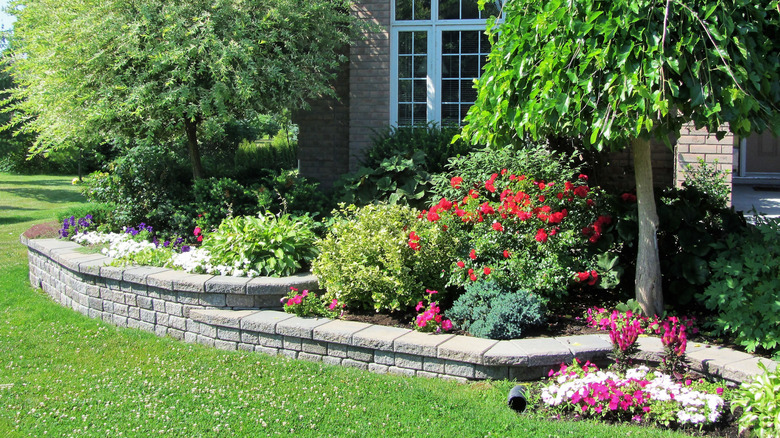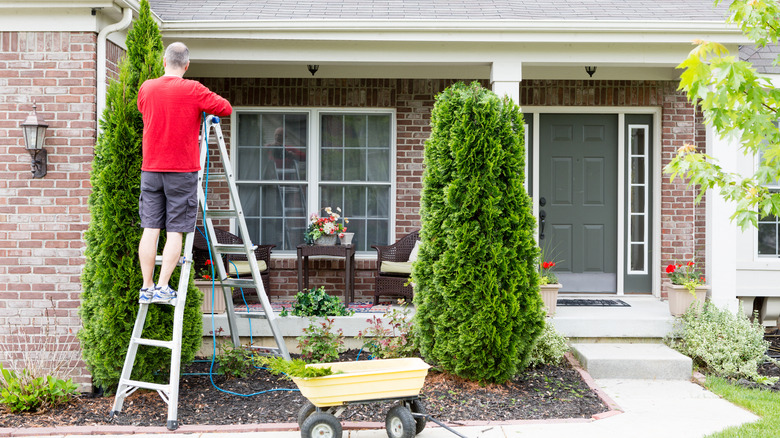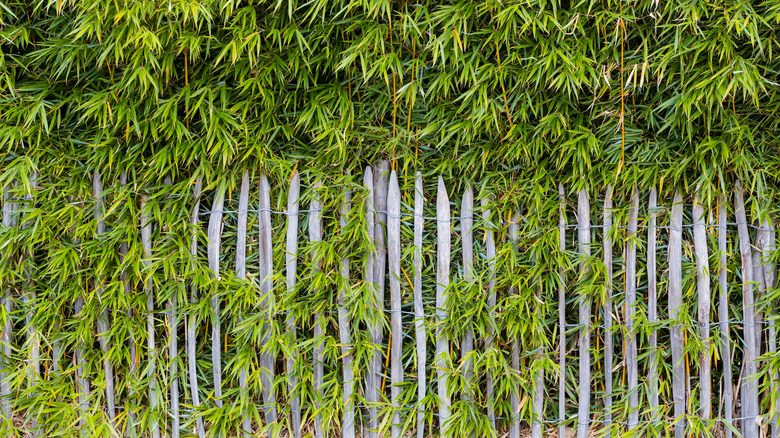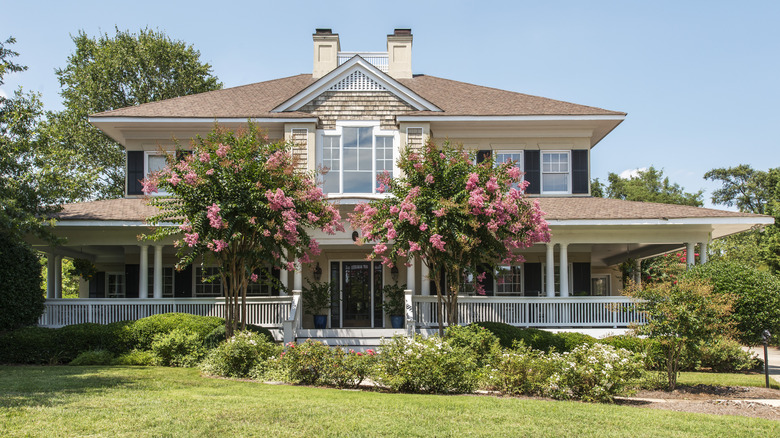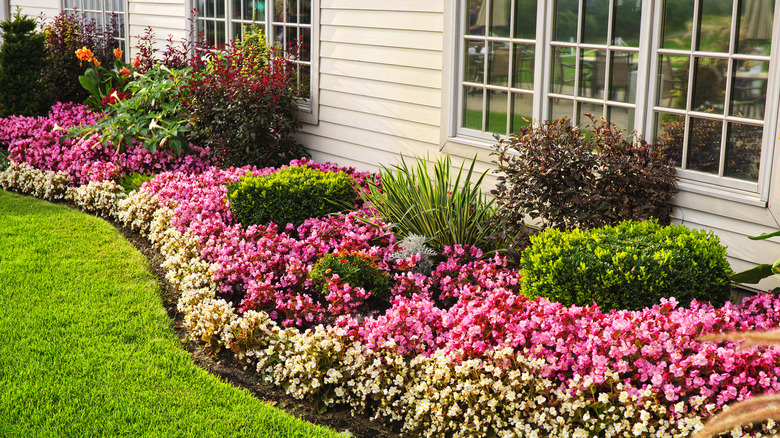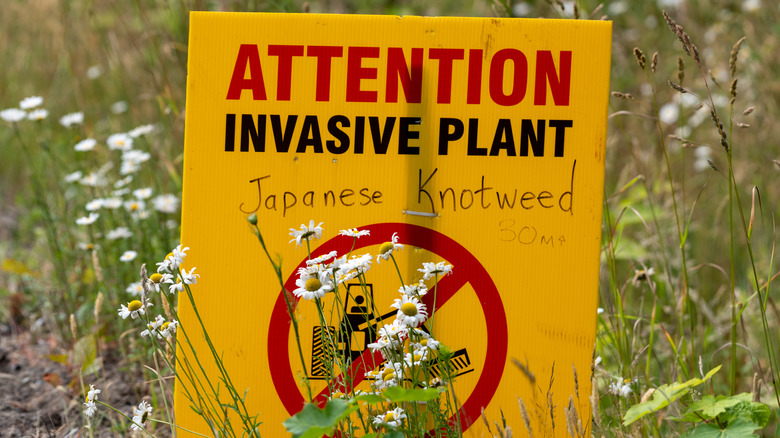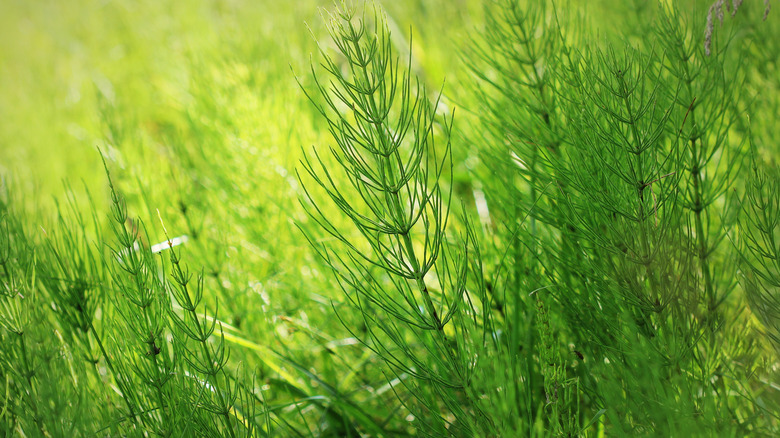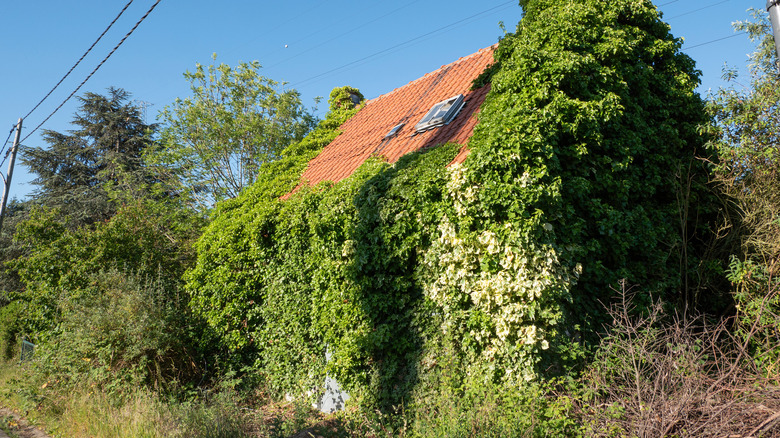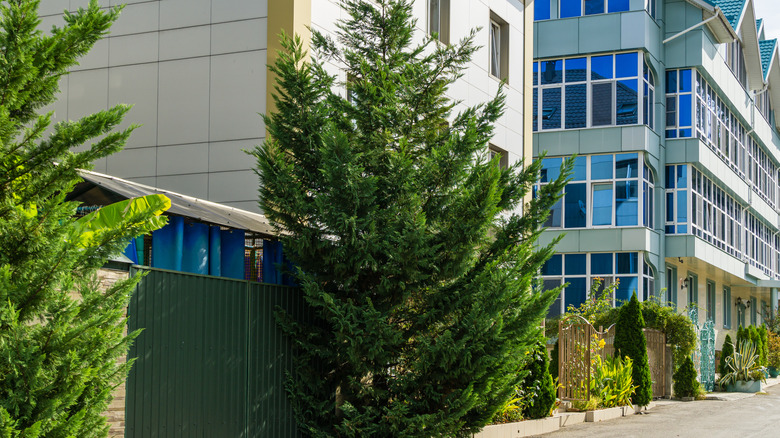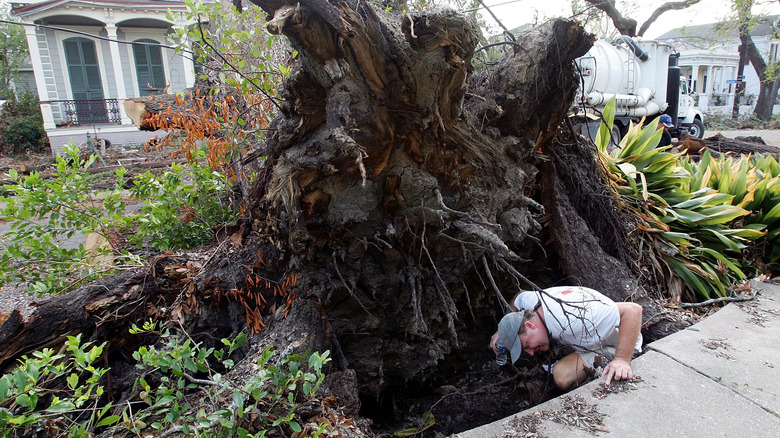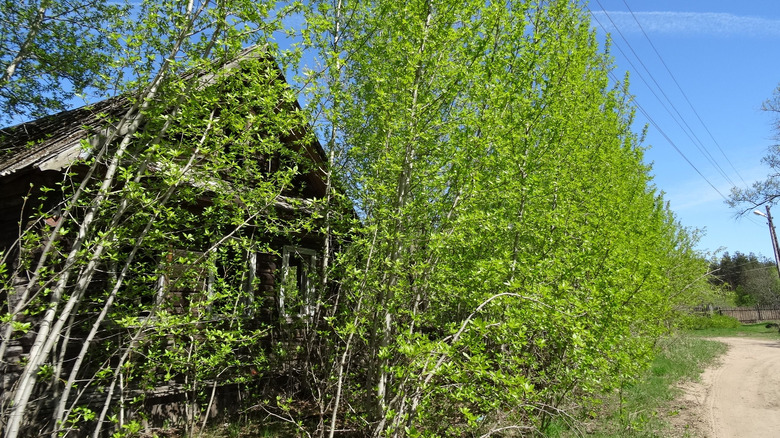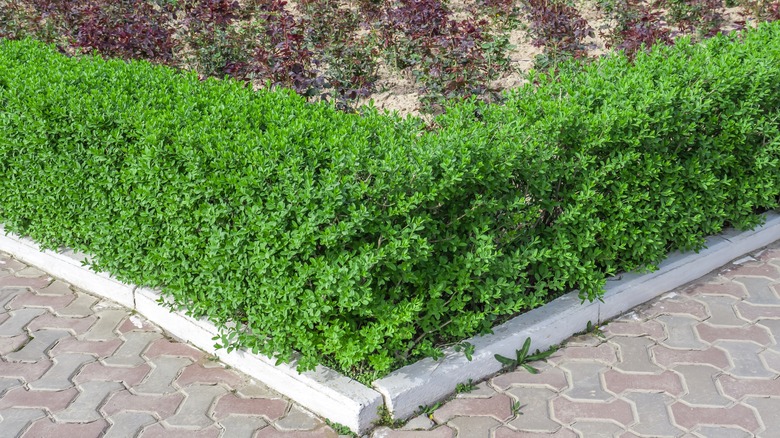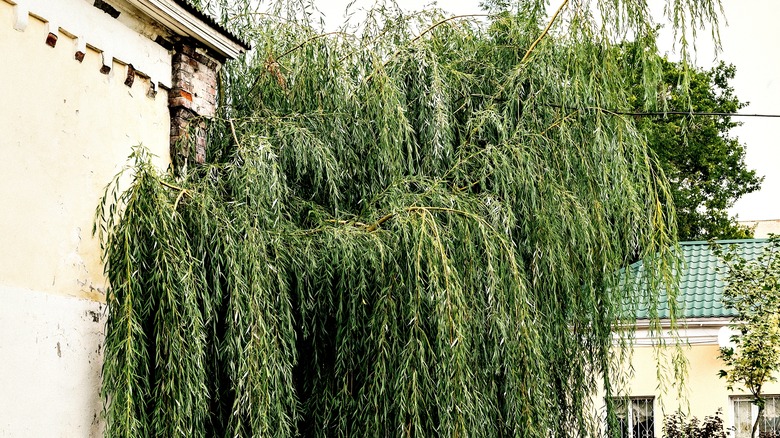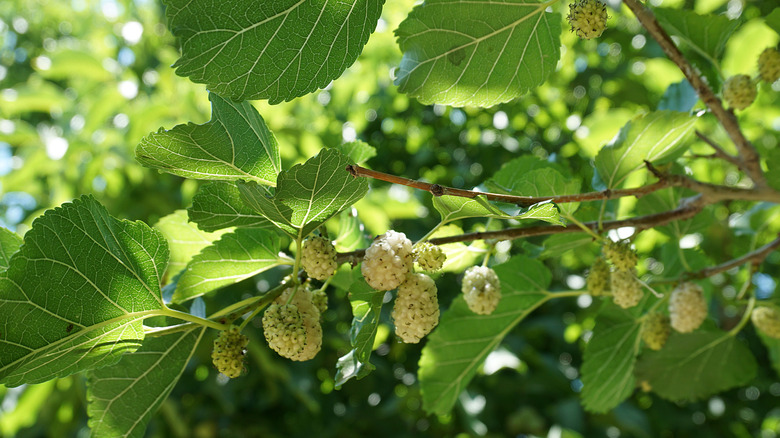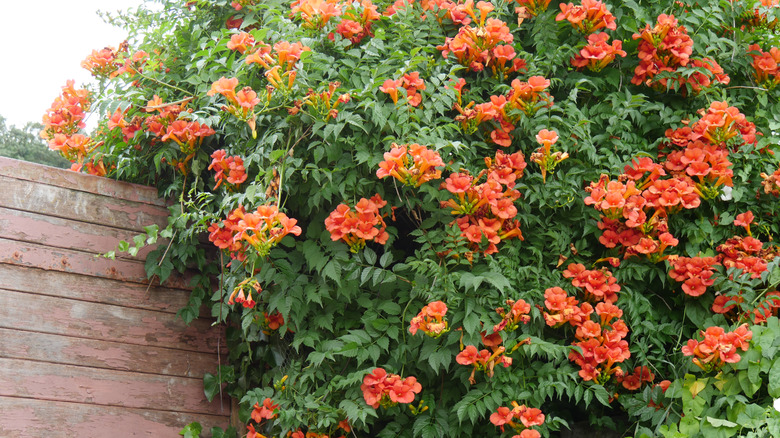Plants You Shouldn't Grow Right Next To Your House
At first thought, you would never believe that the cute little seedling you brought home could grow so strong it could inflict damage, especially not to a structure as substantial as a house. Instead of considering worst-case scenarios, you're probably focusing on elevating your yard and boosting curb appeal. But we're often so caught up with the expectation of beautiful flowers or shade on a hot sunny day that we forget to consider the unexpected damage that can be wielded by our dearest of authorities, Mother Nature.
Some shrubs will grow tall enough to interfere with window air conditioning units, gutters, and even power lines. Some trees have root systems that grow so extensively that they exacerbate cracks in foundations and sewer pipes. Some plants simply spread so fast you'd be hard-pressed to keep up with their pruning before they cover half your house and create a breeding ground for mold and mildew.
With beauty and dollar signs in our eyes, it's all too easy to overlook the fact that nature usually wins. If we want to avoid the mess and expense of structural and other types of damage, we need to be specific about what we grow next to our homes. Here is what to avoid.
Arborvitae can cause damage to roofs and walls
American arborvitae (Thuja occidentalis) and its close cousin, the Green Giant (Thuja standishii x plicata 'Green Giant'), are sturdy evergreens that are often used to create privacy and windbreaks. Some grow 3 feet annually until they reach a maximum height of 40 to 60 feet. Their narrow columnar shape can be misleading; unless they are pruned regularly, these evergreens can spread much wider than expected. As they do, their stiff branches and needles scratch and damage the siding of your house while creating environments for fungi to grow and spread. Arborvitae and the like also tend to grow straight up into eaves and gutter systems.
There's no denying arborvitae make for a grand statement at the entrance of your home. To achieve the look while avoiding the potential of damage to your siding, you have at least two options. First, plant trees 10 to 15 feet away from the foundation and far from overhanging power lines. Second, keep the trees potted, which may help them stay smaller overall, and prune them regularly to a manageable height.
Bamboo can crack plumbing and floors
By some definitions, bamboo is considered a noxious invasive weed. Is it pretty? Yes. Exotic? Of course. But it's also dangerous in terms of wildly unmanageable overgrowth. We're not exaggerating here; a 2019 multi-university study reports that golden bamboo (Phyllostachys aurea) can grow at a rate of 1 inch per hour! That may seem unimaginable, and yet ... there are plenty of homeowners out there who have run into trouble after planting this rapidly expanding grass near their houses. This is because the underground rhizomes will stretch their way into cracks or crevices, wreaking havoc on foundations, floors, and plumbing in the process. The plant itself is so strong that it will then expand the cracks as its trunk thickens.
Since bamboo is such an easily renewable resource, it's generally considered an environmentally friendly building material. Rather than plant it outside, better ways to incorporate it into your home are to purchase bamboo furniture, install bamboo flooring, or keep a small houseplant on the counter to encourage positive feng shui and good luck.
Crepe myrtle can loom over your roof and make a giant mess
Flourishing crepe (or crape) myrtles (Lagerstroemia indica) bring a wash of intense color to the yard. So why wouldn't you choose this gorgeous ornamental to deck out the front of your house? One issue with these beautiful bloomers is that they have a tendency to grow taller than expected, and before you know it, you find yourself with a beastly specimen looming just above roof height and threatening to clog your gutters with its leaves, spent blossoms, and flaky bark. Another issue with crepe myrtles is that all those falling elements make incredible messes of yards and sidewalks. If you were to plant a tree close to your house, you can expect to be sweeping and perhaps cursing the state of your porch and entryway daily.
By no stretch are we suggesting you shy away from including these gorgeous trees in your landscape, especially if you live within their recommended USDA hardiness zones 6 through 9. Just be intentional when planting them. Look up for power lines that may become obstructed, and find a spot in the center of your yard far away from anything you want to keep clean, like the sidewalk, driveway, porch, and front entrance.
Flower beds create excessive moisture
It's tempting to plant overflowing beds of flowers just about everywhere, and considering that a lot of flowers (especially annuals) are temporary and shallow-rooted, they may seem like a great choice along the side of the house. Unfortunately, problems with your foundation can arise due to the excessive moisture from daily watering. Concrete foundations are designed to handle seasonal rains, but if water is continuously seeping in and then freezing, the expansion of the water will cause small cracks that grow over time. Pools of water can also lead to erosion of the surrounding soil and eventual failure of a concrete or pier and beam foundation. Erosion is a difficult and expensive issue to curtail.
We can't blame you if you're determined to adorn your house with colorful blooms, but there are some important steps to take. At the very least, never use the foundation wall as the flower bed's back wall. Leave a few inches of space between the house and the plants, and fill that space with gravel to assist with drainage. Also, make sure your yard is graded to gently slope down and away from the foundation. Using raised garden beds will help increase the space further, which will, in turn, allow for air circulation and better drainage.
Japanese knotweed is super invasive
Imagine an invasive weed that grows more than 10 feet tall and 65 feet wide. Yes, 65 feet wide. Japanese knotweed (Fallopia japonica or Polygonum cuspidatum) is so bad it has basically attained legendary status. In some countries, banks and lenders can refuse to offer mortgages on properties that have an infestation of this nuisance. In fact, it's downright illegal to grow in some areas, and even where it's not illegal to have on your own property, you will be breaking the law if it should spread (and it will) to your neighbor's yard. If it does, you'll be legally responsible for its eradication. And good luck with that because Japanese knotweed is a weed like no other.
Due to all the hubbub around this invasive plant, it's unlikely that you'll find it at a nursery for purchase. But if you already have it growing anywhere on your property and especially if it's close to the house, you need to get on top of managing it. Knotweeds are known to cause structural damage, pop up through 2 inches of solid pavement, and render drainage ditches unusable.
Horsetail damages infrastructure
Common horsetail (Equisetum arvense), or mare's tail, is a weed that is considered invasive in some areas. Similar to bamboo, this plant shoots up from creeping underground rhizomes. It's difficult to get rid of once it has established itself in a yard because the quickly spreading rhizomes grow downwards up to 6 feet. This means they can spread out below the foundation of a structure, causing it to become unstable over time.
Horsetail does not flower, but some people like to grow it so they can use it as an herbal medicine to treat burns, osteoporosis, kidney stones, and more. Even when potted, though, it can still spread to your yard because it reproduces via spores just like its close relatives, the ferns. An infestation of horsetail will be difficult to remove. As Chris Ross of Direct Building Products told Britain's Daily Express, "Many have found it to be the cause of more damage to infrastructure than Japanese Knotweed as it is well known for breaking through paved areas and destroying landscaped areas."
Some weeds look harmless, delicate, and wispy aboveground, but what's happening underneath the dirt is a whole different story. If you have horsetail growing anywhere near your home, it's time to start applying weed killer and digging up those rhizomes.
Ivy can wreak havoc on home walls and open roofs
Is it the bucolic illustration of your old English countryside dreams, or is it an overbearing climber that will cover and suffocate your whole house? Though some climate-conscious gardeners might recommend growing ivy (Hedera helix) on the side of a building to cut down on heat absorption, this is a plant that has the potential to grow out of control to the point of taking over an entire structure, or simply working its way into small cracks and crevices.
Pointed brick houses are in particular danger. If you can believe it, the individual suckers on those thin stems can pull mortar away from between the bricks. They also leech enough moisture that they cause bricks to dislodge from the structure. But ivy won't stop at brick; the trailing vines will stick to siding, slip into cracks in concrete, and wreck gutters. Ivy has been known to grow into eaves and roofs, which causes leaks and opens up enough space to invite wildlife in for refuge. If you want squirrels and birds in your attic, plant an expanse of ivy along your home's foundation. If you prefer your home to remain stable and leak-free, refrain from doing so.
Leyland cypress can crack foundation and grow to looming heights
Leyland cypress trees (× Cuprocyparis leylandii) do not have invasive root systems, but they do have their own special way of impairing foundations. They are very thirsty trees, so much so that they are sometimes planted specifically in areas with poor drainage and clay soil to let the roots suck up the excess moisture and dry out the surrounding area. As the ground loses moisture, though, it contracts, and that's what leads to structural damage. Sometimes the contraction can be so detrimental that it causes a foundation wall to fail and collapse. If you already have a leyland cypress planted close to your foundation and you see any developing cracks, seek professional help immediately.
These evergreen conifers certainly have their uses as fast and tall growing trees that make for dense privacy hedges. But because they can stretch up to 70 feet high, they're not the best option close to a home where limbs can hit power lines, block windows, scrape against siding, or damage gutters.
Oak trees are mighty lightning rods
Mighty is one truly effective adjective for describing oak trees. They stand mighty tall. Their branches grow thick and mighty strong. And in the worst circumstances, they can potentially cause a mighty amount of damage to your house. Mature oak trees weigh thousands upon thousands of pounds, and the larger varieties can grow as tall as 100 feet. Before planting an oak tree, visualize the size it will become and dig your hole far enough away from any structures and power lines so that they won't be damaged should the tree fall.
Did you know oaks are the most common trees to be hit by lightning? The jury is out as to whether that's because of their height or the water content of the bark, but either way, it's a problem for the tree and for your house. Energy and electricity from the bolt can travel through a tree's root system leading straight to your water pipes and perhaps all the way into your home to the fuse box and control panel. To stay safe, plant oak trees at least 20 feet (or much more) from your home.
Poplars are messy trees that ruin plumbing
No one wants to deal with damaged sewer lines. The mess, the stench, the financial hit ... it's enough to make you cringe just thinking about it. For this reason, you can go ahead and cross off poplar trees from your list of potential landscape plants. White poplars (Populus alba) and cottonwood poplars (Populus deltoides) are fast growers particularly deplored by plumbers for their hyper-vigilant water-seeking root systems that will find the tiniest leak in a sewer pipe and commence to strangle the pipe to smithereens in their bids to suck out the moisture.
While it's true that healthy poplar trees can be tall (we're talking up to 200 feet), lean, and gorgeous, when they're growing up on the side of your house, they will likely look more like rambunctious weeds. Poplars are messy trees with brittle wood that really only work in their native habitats along streams and river banks. Simply put, this is one tree species to skip when planning your landscape design.
Privet can take over your house and attract wildlife
Privet (Ligustrum japonicum) is a popular choice for a hedgerow because it grows thick and tall, offering an excellent source of privacy. And we can't deny that it does make a great-looking border plant. Unfortunately, it has a reputation for being problematic and invasive, and planting it close to a foundation is not advised. It will quickly take over a wall, block windows, and potentially grow into small cracks in the cement.
Another thing to consider about privet is that each plant will produce hundreds of berries that will attract all kinds of birds. Songbirds across the yard or high up in trees are wonderful, but they will create an enormous mess right next to your house. Pollen from privet flowers can cause respiratory allergies, and privet berries and leaves are poisonous to humans causing gastrointestinal distress and skin problems that can last up to three days. Keep this plant away from the house if you have pets or children, and instead plant something less problematic like dystilium or ilex.
Willow trees have excessive roots
Weeping willow trees (Salix babylonica) are squarely positioned within the excessive roots category. Imagine the width of a mature tree's canopy and then triple it. Yup! The root system of a healthy weeping willow can stretch to enormous lengths under the ground. Not only do these roots have the potential to damage the foundation of your home and the surface of a patio on the property, but they also pop up throughout the yard, making it a real challenge to get the grass mowed. Planting one of these trees away from the house may not be the best solution either, because you'll also need to take into consideration septic drainage fields and any underground utility lines like electric, sewage, gas, and water. That's right, even if they're not planted near the house, they can still cause damage to the house!
Are they worth the trouble? That's hard to say, because some people just really like the aesthetic value offered by their unique drooping limbs. Weeping willows may be best suited for large properties where they can be left to thrive far away from any living quarters. Got a few acres and a pond way out back? That's where to plant your willow tree.
Mulberry trees produce an unsightly mess
Imagine clearing out all the debris from your patio or driveway, only to be met by dark purple stains and nibbled-through fruits. That's precisely what's in store if you grow mulberry trees (moras spp.), be it their native red variety or the introduced (and weedy!) white mulberry. Standing over 30 feet tall, this species provides the perfect vantage point for birds while laying down a grand buffet for deer, beavers, and raccoons, who adore its leaves, wood, and fruits, respectively.
Although you might be willing to enjoy some wildlife value, you probably wouldn't want them to come knocking at your door. Besides the fruit, the whole tree is slathered with milky sap, leaving you writhing with painful rashes if you brush past. That's on top of tolerating their highly allergenic pollen, which is notorious for causing hayfever. But the worst part is that white mulberry trees can wreak havoc on your drainage system, as their vigorously growing, water-seeking roots love spreading far and wide.
If you still want to plant this bird-attracting tree in your home, given its low maintenance and other veritable attributes, switch to its lower-fruiting cultivars like King White Pakistan and Tehama to save yourself some mess, but ensure you plant them about 15 to 20 feet away from your home. Or, check out the black mulberry tree (Morus nigra), as they're a better fit for homes, growing bushier when left untrained, and fruit only after they hit 15 feet tall.
Trumpet vines damage structural elements
Trumpet vine (Campsis radicans), the musical-sounding flower that adds color and attracts hummingbirds to your yards, is another favorite among homeowners who love to hang it over a trellis. Unfortunately, its ability to put on a 30 to 40-foot growth spurt within a season is exactly what makes it bad news, or rather an invasive weed, per the USDA. Trumpet vines scale the walls by sending out aerial rootlets, in addition to self-seeding, further creating more (undesired) creepers. These suckers muscle their way through everything solid, including the foundation, sidings, shingles, gravel pathways, and other structural elements, causing immense damage. Not to mention, they serve as highways to your heavenly abode for all the tiny ants, spiders, and critters hanging out in their foliage and flowers. So, unless you're game for regular inspection and pruning the foliage before it sets seeds, do yourself a favor and steer clear of these woody vines.
To boot, trumpet creepers also serve as fire ladders, thanks to their high inflammability (according to the NC State Extension). Plus, if you have a chance to make contact with their sap while walking out the door, good luck with the rashes! Their alt name, 'cow-itch vine,' is well-earned, indeed. Take our advice and leave the vines in your garden where they can be mowed down easily along with the grass, or keep them containerized and wired.
